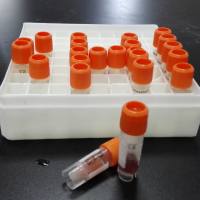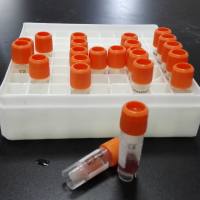蛋白质呈色反应—坂口反应实验
互联网
【实验原理】
蛋白质在碱性溶液中与次氯酸盐(或次溴酸盐)和α-萘酚作用产生红色的产物。这是由于蛋白质分子中精氨酸胍基的特征反应。许多胍的衍生物如胍乙酸、胍基丁胺等也发生此反应。精氨酸是唯一呈正反应的氨基酸,反应灵敏度达1:250000。
【Principle】
Protein react with sodium bromate solution and α-naphthol solution in alkali condition to produce red component. This is a special reaction of arginine’s carbamidine, which is useful in quantitating and determining the natures of protein and the amino acid. The reaction is shown as below.
生成的氨可被次溴酸钠氧化生成氮。在次溴酸钠缓慢作用下,有色物质继续氧化,引起颜色消失,因此过量的次溴酸钠对反应不利。加入浓尿素,破坏过量的次溴酸钠,能增加颜色的稳定性。此反应可以用来定性鉴定含有精氨酸的蛋白质和定量测定精氨酸的含量。
【 试剂 】
1.蛋白质溶液:与双缩尿反应相同
2.次溴酸钠溶液
3.10%NaOH溶液
4.0.2%α-萘酚溶液
5.0.01%精氨酸溶液
【实验操作】
1. 于
试管
中加入蛋白质溶液1ml,再加10%NaOH溶液0.5ml,0.2%α-萘酚2滴,混合后再加次溴酸钠溶液2滴,观察现象
2. 取0.01%精氨酸溶液1ml,按上述操作观察现象
【Reagent】
1.Protein solution (the same as biuret reaction)
2.Sodium bromate solution
3. 10% NaOH solution
4.0.2%α- naphthol solution
5. 0.01% arginine solution
【Procedures】
1.1ml of protein solution is added into a test tube, then 0.5 ml of 10%NaOH solution and two drops of 0.2%α- naphthol are added. After mixing, 2 drops of sodium bromate solution are added, and then observe the phenomenon.
2.Add 1 ml of 0.01% arginine solution according to the same procedure above,then observe the phenomenon.









